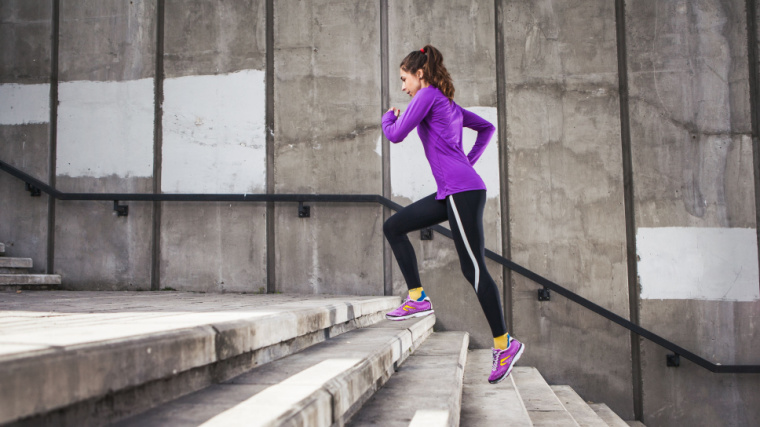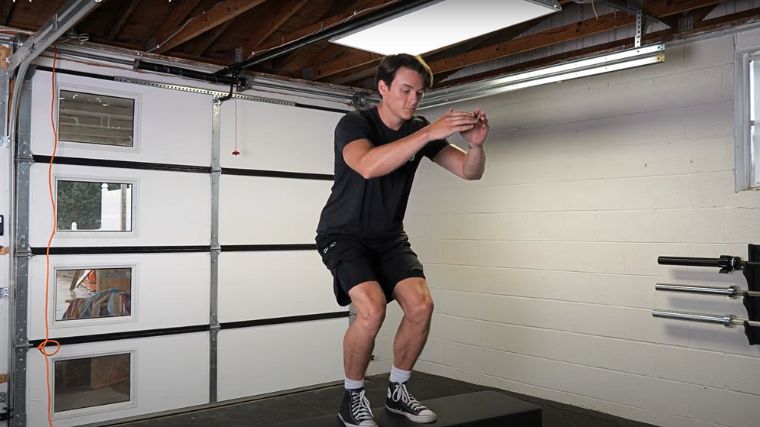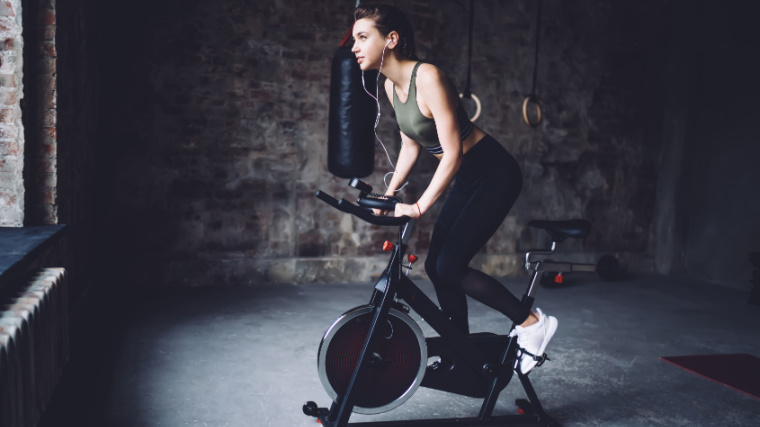You’ve just started surrendering to your cardio-happy friend who insists that you do something in the gym aside from picking up heavy barbells and putting them back down. Fine, you say, you’ll do…cardio. But the query of HIIT versus LISS — high-intensity interval training versus low-intensity steady-state cardio — arises. You want to do whichever is better.

The question is: better at what? Are you aiming to get more powerful and explosive? To process oxygen more efficiently? To improve your heart health or work capacity? Here, we’ll lay out for you whether HIIT or LISS can give you what you’re going for — and when you might want to do both.
Editor’s Note: The content on BarBend is meant to be informative in nature, but it should not be taken as medical advice. When starting a new training regimen and/or diet, it is always a good idea to consult with a trusted medical professional. We are not a medical resource. The opinions and articles on this site are not intended for use as diagnosis, prevention, and/or treatment of health problems. They are not substitutes for consulting a qualified medical professional.
HIIT Vs. LISS Cardio Differences
The biggest differences between HIIT and LISS can be found in their names. In one corner, you’ve got high-intensity training; on the other, you’ve got low-intensity training. One happens in intervals — spurts of big energy — while the other occurs in a steady state of consistent, trudging effort.
Pros and Cons of HIIT
Here are your pros and cons in a nutshell.
Pros of HIIT
The benefits of HIIT workouts are broadly associated with their brevity and ferocity — both physically and mentally. Because these workouts so intensely test and retest your physical and mental limitations, they confer their benefits quickly and noticeably.
Shorter Workouts
HIIT workouts are designed to have you bring all-out effort into short intervals of work followed by periods of active rest. Because you’re using so much energy, most HIIT workouts draw to a close before they reach the 20-minute mark, taking less time than other workout types. If you’re hoping to reap your training rewards in a time-efficient manner, this is a classic advantage to HIIT.
Increased Power and Muscularity
Whether your HIIT session includes sprints on the treadmill, burpees, wall balls, or box jumps, HIIT generally involves explosive plyometric exercises.

[Read More: The 5 Best HIIT Treadmill Workouts to Bring Some Heart to Your Training]
These recruit very large muscle groups, often across your entire body. In the process, your large muscle groups will be pushed to the limit, which may help increase your muscle mass over time. (1)
Improved Cardiovascular Health
Though LISS is often the form of cardio that people do to improve overall cardiovascular health — a long jog is, after all, what many people picture when they say they’re “doing cardio” — HIIT is also great for overall wellness.
Research indicates that HIIT protocols can improve all kinds of markers of cardiovascular health, ranging from improved exercise capacity, anaerobic endurance, aerobic endurance, and maximal oxygen uptake to other improved metabolic health indicators. (2)
More Workout Variety
Because HIIT combines a series of short intervals of exercise, the door is open for you to incorporate plenty of variety. So whether you use a strict Tabata training protocol, or you incorporate all of the classic moves of a CrossFit workout, all of it can qualify as HIIT as long as you go all out.
That variety may well keep you interested and fend off the monotony that is all too often associated with promoting your long-term cardio health.
Cons of HIIT
HIIT pushes your body to the brink of failure, which can be a huge pro for many athletes. Challenging yourself and discovering new capabilities is precisely the point. But on the flip, HIIT can exact a heavy cost on your muscles and joints even when performed correctly.
Higher Impact
HIIT workouts often involve some heavy-hitting exercises — think jumping lunges and all-out sprints. While you can certainly swap in lower-impact moves like tempo bodyweight squats, the plyometric nature of the moves is meant to jack up your heart rate and involve big muscle groups.
[Read More: 5 Perfect Pre and Post-HIIT Workout Meals (With Kettlebell Kitchen)]
As such, you may encounter uncertain foot placements or lapses in form, particularly when fatigue sets in. Of course, this can happen during any type of exercise, including low-intensity sessions. But the higher impact that certain forms of HIIT can have may be a little rough on your joints.
Tempting to Cut Short
Since HIIT workouts are often daunting, and performed in fixed sets with limited rest periods, it can be tempting to shave one or two grueling intervals from your regimen. Sometimes bailing out of a HIIT workout that has already taxed your body is a wise decision — you’ll learn to listen to your body as you become a more experienced athlete.
[Read More: 3 Simple and Effective Methods to Increase Workout Intensity]
But other times, you may want to stop before the best benefits will kick in because you’re not mentally in the game. That can be a discouraging aspect of HIIT for many — while, of course, it’s precisely what others love about it.
Higher Mental Barrier of Entry
HIIT workouts require you to be dialed in at all times. By their very nature, HIIT exercises are intended to evoke an all-out effort from you. This means that from the moment the clock starts, you’re aiming for peak performance.
[Read More: Low Impact, 15-Minute HIIT Kettlebell Circuit]
It can be tough to lace up your cross-training shoes and pump yourself up for a workout that you know is going to be extra intense. If you’re coming across that barrier, try to think of your warm-up as part of the workout to give yourself a more gradual build-up. Use the dynamic warm-up to get your mind in the game as well as your body.
Pros and Cons of LISS
Low-intensity steady-state cardio is the kind of traditional cardio training you might automatically think of when someone mentions “doing” cardio. A 5k run or a jog during your lunch break — even a solid dog-walking session — all can qualify as LISS cardio.
With LISS training, you’re aiming to do your cardio exercise (say, running) at a pace you can sustain without stopping for a given amount of time — usually, over 15 minutes or so.
Pros of LISS Training
Most of the benefits of LISS training are linked to their comparatively relaxed exertion levels, relative freedom, and high health rewards. With LISS workouts, time is your ally, and the accumulated benefits of the training style will gradually add up over many workouts.
Sustainable But Effective
LISS offers you the chance to increase your stamina and develop your cardio health in a relatively relaxed fashion without placing undue stress on muscles, tendons, and joints. That said, if you choose running as your modality, you will be placing a relatively higher impact on your joints than, say, walking or using a rowing machine. Plan your workouts accordingly.
Simple Structure
By their very nature, LISS workouts eliminate race-against-the-clock scenarios from your training routine in favor of a more moderate, almost leisurely, approach. As long as you’re maintaining proper form, you don’t have to think much about what you’re doing or how to do it.

[Read More: Study: Low Vs High Effective Training Frequency for Strength and Mass]
All you have to do is choose your modality — a brisk walk, a jog, or perhaps a session on the exercise bike? — and set a pace that you know you can sustain over time. Plug in your favorite podcast and the rest takes care of itself.
Improved Heart Health
It doesn’t have to be high-impact to have a big impact on your health. Low-impact cardio like cycling or jogging for extended periods has been proven to lower blood pressure and reduce the onset of heart disease. (3) LISS training enables you to help your heart and overall health without quite the intensity that HITT requires.
Beginner-Friendly
You don’t have to step foot in a gym to get your LISS on. All you have to do is head outside and take a walk. Even walking at a steady pace “counts” as LISS, so athletes who are new to or returning to training after a break can cruise in gradually.
Cons of LISS Training
Depending on your fitness goals, you might not find what you’re searching for with LISS.
Limited Strength and Power Gains
Unless you’re coming back from truly not training or moving much at all, low-intensity steady-state cardio is not a form of exercise that is meant to help you build muscle. (4) Similarly, you won’t be boosting your power production or strength all that much with low-intensity training like this.
[Read More: Try These 8 Intensity Training Techniques For Your Bodybuilding Workouts Up a Notch]
That said, if you’re aiming to get stronger and improve your power production, you certainly can use LISS to supplement your training. You can, indeed, use LISS to improve your cardiovascular fitness while also focusing on your strength and power work on the platform.
Here are two guides for how to train for strength and endurance or running concurrently:
- Everything You Need to Know About Endurance Training for Strength Athletes
- How to Balance Running and Strength Training, No Matter Your Goals
Reduced Variety
For many athletes, the straightforward nature of LISS workouts are undoubtedly a boon — plug in a good playlist and get after one goal. But athletes who have difficulty doing the same thing (running, for example) for a long period of time may find this tricky.
And the nature of LISS training generally the method to types of cardio that can be done for long spans, like jogging, casual elliptical training, or low-speed rowing and swimming. If you don’t like those modalities, you might not be in luck.
Time-Consuming
As opposed to the quick, intense movement snacks provided by HIIT sessions, LISS training takes comparatively longer. You absolutely can have a short LISS session, lasting shorter than 20 minutes (by comparison, that’s a long HIIT session). But in general, you want LISS sessions to be upwards of 20 or 30 minutes. For some, that can pose a significant barrier to entry.
If that’s presenting a challenge, remember that it is definitely possible to split your LISS training into smaller sessions — say, four quick 10-minute walks throughout the day instead of one 40-minute session.
How to Choose Between HIIT and LISS
Your choice between HIIT and LISS may depend on what you intend to do between strength workouts. If you’re spending three days a week cranking out powerlifting sets that exhaust your large muscles, LISS might provide your body with the break it requires.

[Read More: High Volume vs. Maximum Intensity: How to Choose?]
However, if you favor a training approach that may further enhance your strength, HIIT is the way to go. Just make sure you’re programming yourself enough recovery time to maximize your gains.
Workouts
Your standard HIIT and LISS workout are going to be quite different from each other, of course. Here’s how.
HIIT Workout
In general, HIIT workouts tend to focus on large muscle groups, compound exercises, and plyometrics. As such, you’ll generally get a full-body workout.
This HIIT workout example will fully engage your upper body and lower body, fry your legs, and get your heart pumping very rapidly. It incorporates only three different movements that are very simple, yet very effective. You’ll feel the compounding effects from the effort very quickly.
After four minutes of easy jogging and dynamic stretches to warm up, perform four cycles of the following exercises at a maximum effort. Conclude with four minutes of walking and optional stretches as a cooldown.
- 30 Seconds of Sprinting
- 30 Seconds Rest
- 30 Seconds of Jump Squats
- 30 Seconds Rest
- 30 Seconds of Burpees
- 30 Seconds of Rest
- Repeat circuit for four total rounds.
LISS Workout
LISS workouts tend to be extremely simple, and this example is no exception. After some dynamic stretches, you’ll work your “ramp-up” effort into phase one of the session.
- Phase One: 15 minutes of Brisk Walking
- Phase Two: 30 minutes of Slow Jogging
- Phase Three: 15 minutes of Brisk Walking
Of course, you can customize these time periods as needed. For example, you can cut it down to five to 10 minutes of brisk walking on either end and only 10 to 20 minutes of jogging.
Your Takeaways
So, HIIT versus LISS: who wins? Turns out, you can’t go wrong with either, as long as you’re emphasizing recovery in your program. Here’s how it breaks down:
- HIIT workouts are very intense and use intervals — so, you’ll be going all out for a short period, doing some active rest, then repeating.
- LISS workouts are by nature low-intensity and continuous — so, you’ll be performing a continuous effort (say, jogging or walking) that you can sustain without rest for a longer period of time.
- HIIT and LISS cardio both improve overall cardiovascular fitness and metabolic health.
- HIIT may help you improve power, strength, and musculature.
- LISS is very beginner-friendly, which can help you build the base of a sustainable, long-lasting program.
- HIIT workouts are quick and time-efficient, while LISS workouts tend to take longer.
- HIIT workouts tend to be higher impact on your body while LISS workouts may have a lower impact on your joints and body overall (unless you’re running for long distances).
FAQs
If you’re still trying to decide whether a HIIT workout or an LISS workout is the ideal complement for the rest of your training routine, we’ve got the answers to some common questions below.
While HIIT and LISS naturally both burn calories — because they require energy — neither form of cardio is necessarily very effective at promoting sustainable fat loss. (5)
In terms of how they compare directly to each other, you may have heard about EPOC: excess post-exercise oxygen consumption. You burn a lot of calories during HIIT since you’re hitting it so hard, and then supposedly your body continues burning calories at a higher rate after. But, studies have shown that the effect of this isn’t actually that significant over the course of the day. (6) So the difference between HIIT and LISS calorie burn may well even out.
The most effective way to promote fat loss, if that’s a goal of yours, seems to be to manage a balanced and sustainable approach to nutrition with finding a form of fitness that you enjoy enough to continue over time. (7) That sustainability and consistency seems to help more than anything. (7)
Studies have demonstrated that HIIT and LISS workouts have roughly equivalent results on cardiovascular health, with similar reductions in blood pressure. (8) While HIIT workouts have the additional benefit of taking less time, LISS aerobic exercise may place your joints under less stress, especially if you’re running with good form.
Twenty minutes of HIIT per day is more than adequate. It is often difficult to sustain the all-out intensity required by a HIIT session beyond 20 minutes without suffering major declines in form. If you’re doing HIIT each day, make sure you’re recovering well enough between sessions to maintain your energy and strength.
References
- Caparrós-Manosalva C, Garrido-Muñoz N, Alvear-Constanzo B, Sanzana-Laurié S, Artigas-Arias M, Alegría-Molina A, Vidal-Seguel N, Espinoza-Araneda J, Huard N, Pagnussat AS, Sapunar J, Salazar LA, Marzuca-Nassr GN. Effects of high-intensity interval training on lean mass, strength, and power of the lower limbs in healthy old and young people. Front Physiol. 2023 Sep 27;14:1223069.
- Atakan MM, Li Y, Koşar ŞN, Turnagöl HH, Yan X. Evidence-Based Effects of High-Intensity Interval Training on Exercise Capacity and Health: A Review with Historical Perspective. Int J Environ Res Public Health. 2021 Jul 5;18(13):7201.
- Lee DC, Pate RR, Lavie CJ, Sui X, Church TS, Blair SN. Leisure-time running reduces all-cause and cardiovascular mortality risk. J Am Coll Cardiol. 2014 Aug 5;64(5):472-81.
- Konopka AR, Harber MP. Skeletal muscle hypertrophy after aerobic exercise training. Exerc Sport Sci Rev. 2014 Apr;42(2):53-61.
- Keating SE, Johnson NA, Mielke GI, Coombes JS. A systematic review and meta-analysis of interval training versus moderate-intensity continuous training on body adiposity. Obes Rev. 2017 Aug;18(8):943-964.
- Gore CJ, Withers RT. Effect of exercise intensity and duration on postexercise metabolism. J Appl Physiol (1985). 1990 Jun;68(6):2362-8.
- Fuentes Artiles R, Staub K, Aldakak L, Eppenberger P, Rühli F, Bender N. Mindful eating and common diet programs lower body weight similarly: Systematic review and meta-analysis. Obes Rev. 2019 Nov;20(11):1619-1627.
- Tamayo Acosta J, Sosa Gomez AE, Samuel S, Pelenyi S, Acosta RE, Acosta M. Effects of Aerobic Exercise Versus High-Intensity Interval Training on V̇O2max and Blood Pressure. Cureus. 2022 Oct 15;14(10):e30322.
Featured Image: oleksboiko / Shutterstock
The post HIIT Vs. LISS — Which Type of Cardio Is Better? appeared first on BarBend.

